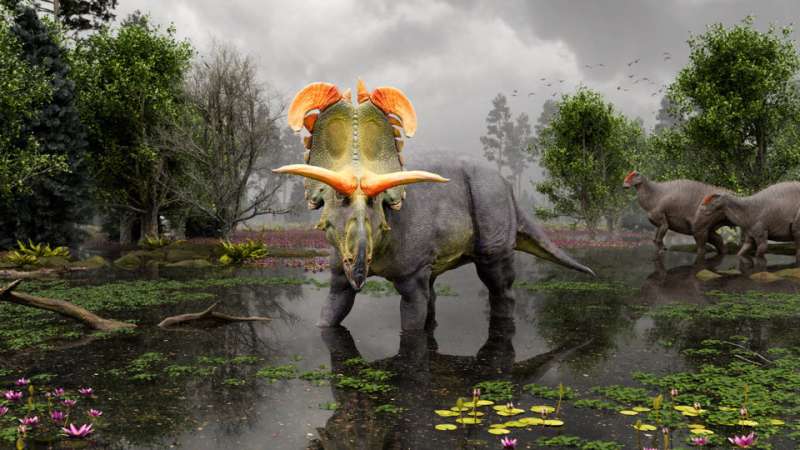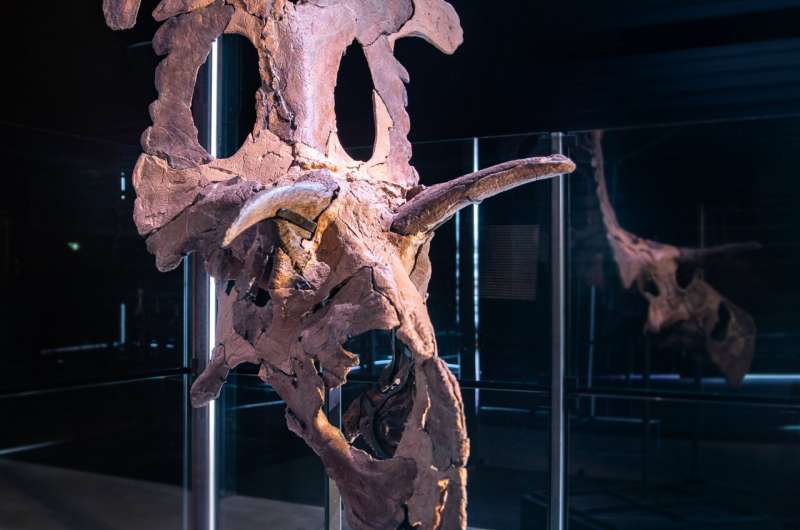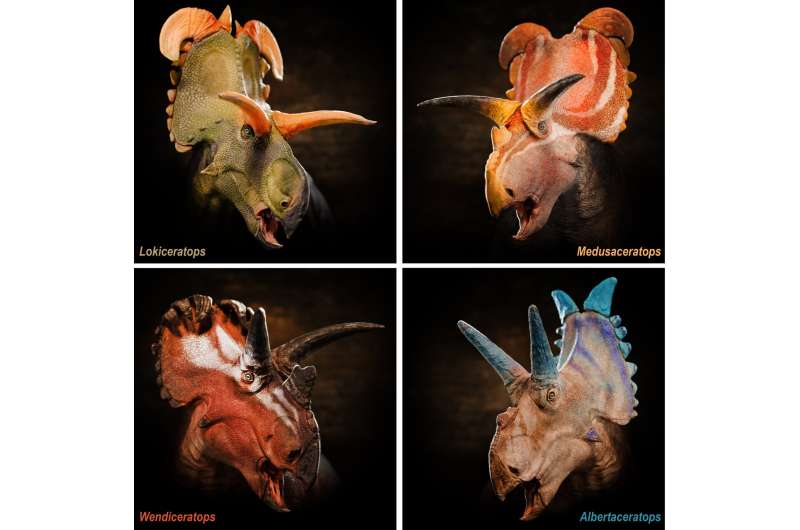This article has been reviewed according to Science X's editorial process and policies. Editors have highlighted the following attributes while ensuring the content's credibility:
fact-checked
peer-reviewed publication
trusted source
proofread
The ornate horns of ancient marvel Lokiceratops point to evolutionary insights

What do you get when you cross Norse mythology with a 78-million-year-old ancestor to the Triceratops? Answer: Lokiceratops rangiformis, a plant-eating dinosaur with a very fancy set of horns.
The new dinosaur was identified and named by Colorado State University affiliate faculty member Joseph Sertich and University of Utah Professor Mark Loewen. The dinosaur's name, announced today in the journal PeerJ, translates roughly to "Loki's horned face that looks like a caribou."
Loewen and Sertich, co-lead authors of the study, dubbed the new species Lokiceratops (lo-Kee-sare-a-tops) rangiformis (ran-ɡi-FOHR-mees) because of the unusual, curving blade-like horns on the back of its frill—the shield of bone at the back of the skull—and the asymmetrical horns at the peak of the frill, reminiscent of caribou antlers.
"The dinosaur now has a permanent home in Denmark, so we went with a Norse god, and in the end, doesn't it just really look like Loki with the curving blades?" Loewen said, referring to the trickster god's weapon of choice.
Loewen, a paleontologist at the Natural History Museum of Utah, and Sertich, a paleontologist with the Smithsonian Tropical Research Institute, are both scientific consultants for the Museum of Evolution in Denmark, Lokiceratops's new home.
"It's one of those stories with a happy ending, where it didn't go to somebody's mansion," Sertich said. "It ended up in a museum, where it will be preserved forever so people can study it and enjoy visiting it."
New dinosaur discovery
Lokiceratops was discovered in 2019 in the badlands of northern Montana, two miles (3.2 kilometers) south of the U.S.-Canada border. Sertich and Loewen helped reconstruct the dinosaur from fragments the size of dinner plates and smaller. Once they had pieced the skull together, they realized the specimen was a new type of dinosaur.
Estimated to be 22 feet (6.7 meters) long and weigh 11,000 pounds (5 metric tons), Lokiceratops is the largest dinosaur from the group of horned dinosaurs called centrosaurines ever found in North America. It has the largest frill horns ever seen on a horned dinosaur and lacks the nose horn that is characteristic among its kin.

"This new dinosaur pushes the envelope on bizarre ceratopsian headgear, sporting the largest frill horns ever seen in a ceratopsian," Sertich said in a press release announcing the dinosaur's unveiling at the Natural History Museum of Utah, where a replica is displayed. "These skull ornaments are one of the keys to unlocking horned dinosaur diversity and demonstrate that evolutionary selection for showy displays contributed to the dizzying richness of Cretaceous ecosystems."
Sertich likened dinosaur horns to feathers on birds. Birds use feather colors and patterns to differentiate their own species among other, similar species of birds.
"We think that the horns on these dinosaurs were analogous to what birds are doing with displays," Sertich said. "They're using them either for mate selection or species recognition."

What Loki's horns tell us about dinosaurs
Lokiceratops was excavated from the same rock layer as four other dinosaur species, indicating that five different dinosaurs lived side by side 78 million years ago in the swamps and coastal plains along the eastern shore of Laramidia, the western landmass of North America created when a seaway divided the continent. Three of these species were closely related but not found outside the region.
"It's unheard-of diversity to find five living together, similar to what you would see on the plains of East Africa today with different horned ungulates," Sertich said.
Unlike the broad range of large wild mammals that roam the U.S. West today, such as elk, these ancient animals were geographically limited, he added. Loki's discovery provides evidence that these species evolved rapidly within a small area, a process sometimes seen in birds.
By the time Triceratops came onto the scene 12 million years later, regional differences had been homogenized into just two species of horned dinosaurs from Canada to Mexico—possibly in response to a more homogenous climate, Sertich said.
The study shows that dinosaur diversity has been underestimated and presents the most complete family tree of horned dinosaurs to date.
"Lokiceratops helps us understand that we are only scratching the surface when it comes to the diversity and relationships within the family tree of horned dinosaurs," Loewen said.
More information: Lokiceratops rangiformis gen. et sp. nov. (Ceratopsidae: Centrosaurinae) from the Campanian Judith River Formation of Montana reveals rapid regional radiations and extreme endemism within centrosaurine dinosaurs, PeerJ (2024). DOI: 10.7717/peerj.17224. peerj.com/articles/17224
Journal information: PeerJ
Provided by Colorado State University





















